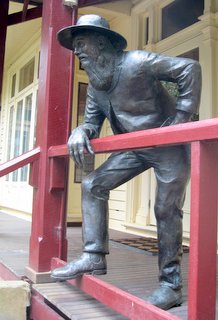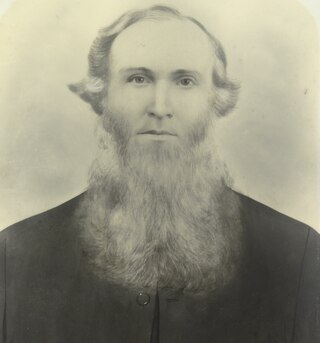
"The Man From Ironbark" is a poem by Australian bush poet Banjo Paterson. It is written in the iambic heptameter.

Charles Harpur was an Australian poet and playwright. He is regarded as "Australia's most important nineteenth-century poet."
"Bell-Birds" is a poem by Australian writer Henry Kendall that was first published in The Sydney Morning Herald on 25 November 1867.
"The Creek of the Four Graves" is a poem by Australian writer Charles Harpur that was first published in three parts in The Weekly Register of Politics, Facts and General Literature on 9 August, 16 August and 23 August 1845.
"Where the Dead Men Lie" is a poem by Australian poet Barcroft Boake. It was first published in The Bulletin magazine on 19 December 1891, and later in the poet's poetry collection Where the Dead Men Lie, and Other Poems (1897).
"The Last of His Tribe" is a poem by Australian writer Henry Kendall that was first published in The Sydney Morning Herald on 27 September 1864, under the title "Woonoona: The Last of His Tribe".
Andy's Gone With Cattle is a poem by Australian writer and poet Henry Lawson. It was first published in The Australian Town & Country Journal on 13 October 1888.
"Bill the Bullock Driver" is a poem by Australian writer Henry Kendall that was first published in The Australian Town and Country Journal on 1 April 1876.

The Teams is a poem by Australian writer and poet Henry Lawson. It was first published in the Australian Town and Country Journal on 21 December 1889. It was later published in the poet's poetry collection In the Days When the World Was Wide and Other Verses in 1896.
Where the Pelican Builds is a poem by Australian poet Mary Hannay Foott. It was first published in The Bulletin magazine on 12 March 1881, and later in the poet's collection Where the Pelican Builds and Other Poems (1885).
The Wind at Your Door (1959) is a one-poem volume by Australian poet R. D. Fitzgerald. The poem was originally published in The Bulletin on 17 December 1958, and later in this 275 copy Talkarra Press limited edition, signed by the author. It won the Grace Leven Prize for Poetry in 1959.

The Oxford Book of Australasian Verse (1918) is anthology of poems by Australian and New Zealand poets edited by Walter Murdoch. It was published in hardback by Oxford University Press in London in 1918.
"The Old Bush Road" (1892) (aka is a poem by Australian poet Jennings Carmichael.
"A Storm in the Mountains" (1856) is a poem by Australian poet Charles Harpur.
"A Bushman's Song" (1892) is a poem by Australian poet A. B. Paterson.
"A Coast View" (1857) is a poem by Australian poet Charles Harpur, also known by the title "Coast Scenery".
"Nationality" is a poem by Australian poet Mary Gilmore. It was first published in Australian Poetry 1942, edited by Robert D. Fitzgerald in 1942, and later in the poet's collection Selected Verse, and other Australian poetry anthologies.
"The Orange Tree" is a poem by Australian poet John Shaw Neilson. It was first published in The Bookfellow on 15 February 1921, and later in the poet's collections and other Australian poetry anthologies.
"The Beautiful Squatter" (1845) is a poem by Australian poet Charles Harpur.
"Middleton's Rouseabout" is a poem by Australian poet Henry Lawson. It was first published in The Freeman's Journal on 8 March 1890, and later in the poet's collections and other Australian poetry anthologies.



